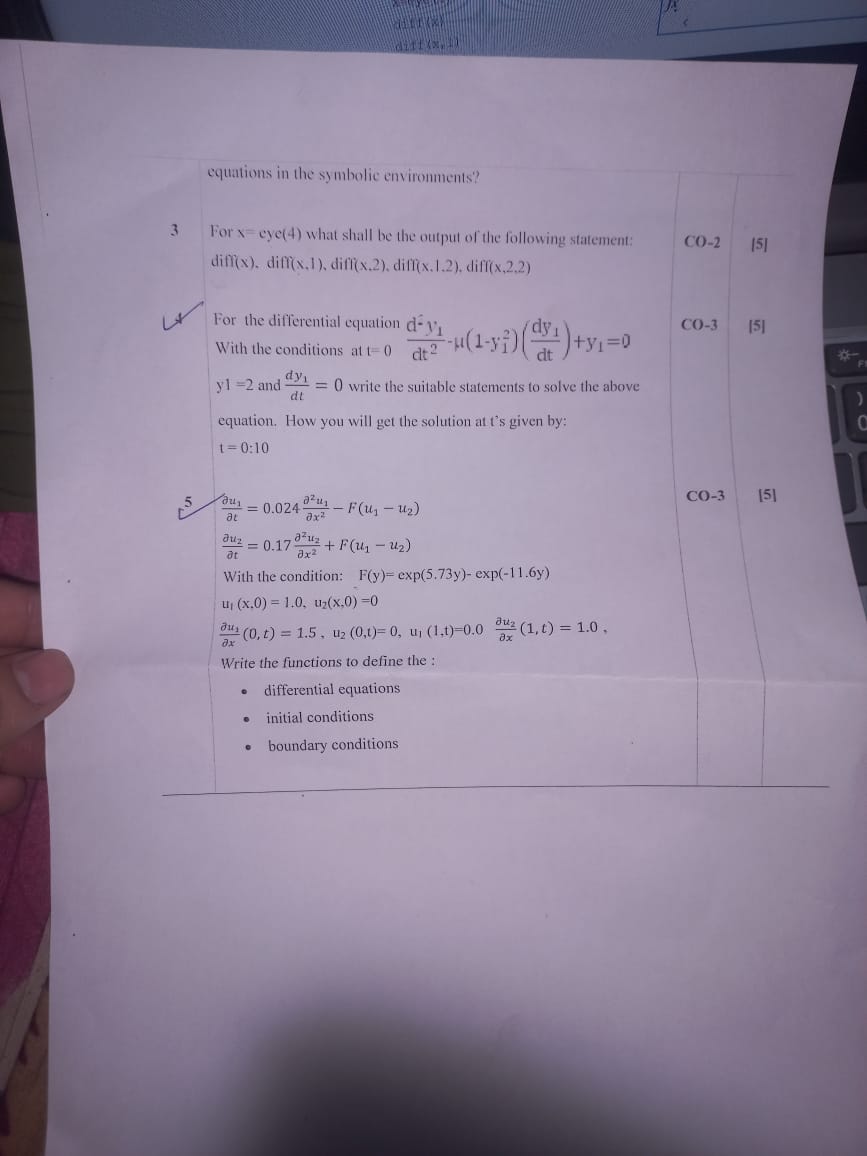For x = eye(4) what shall be the output of the following statement: diff(x,1), diff(x,2), diff(x,1,2), diff(x,2,2)? For the differential equation d²y1/dt² - μ(1 - y1²)(dy1/dt) + y1... For x = eye(4) what shall be the output of the following statement: diff(x,1), diff(x,2), diff(x,1,2), diff(x,2,2)? For the differential equation d²y1/dt² - μ(1 - y1²)(dy1/dt) + y1 = 0 with the conditions at t = 0, y1(2) and dy1/dt = 0, write the suitable statements to solve the above equation. How will you get the solution at t's given by: t = 0:10? For the equation: ∂u1/∂t = 0.024 ∂²u1/∂x² - F(u1 - u2) with the condition: F(y) = (y(5.73) - exp(1.69)) and initial conditions u1(x,0) = 1.0, u2(x,0) = 0, ∂u1/∂x(0,t) = 1.5, u2(0,t) = 0, u1(1,t) = 0. Write the functions to define the differential equations, initial conditions, and boundary conditions.

Understand the Problem
The question involves solving several differential equations under specific conditions. It asks for the output of a symbolic computation, the formulation of statements to solve a given differential equation, and the writing of functions to define initial conditions and boundary conditions.
Answer
Outputs for `diff` functions: \[ \text{diff}(x, 0) = x, \quad \text{diff}(x, 1) = 0, \quad \text{diff}(x, 2) = 0 \] Differential equation form: $$ \frac{d^2y_1}{dt^2} - \mu(1-y_1^2)\frac{dy_1}{dt} + y_1 = 0 $$
Answer for screen readers
-
Outputs for
diffFunctions:
[ \begin{align*} \text{diff}(x, 0) & = x \ \text{diff}(x, 1) & = 0 \ \text{diff}(x, 2) & = 0 \ \text{diff}(x, 1, 2) & = 0 \ \text{diff}(x, 2, 2) & = 0 \end{align*} ]
- Differential Equation Solution:
The symbolic solution obtained from specifying the initial conditions.
Steps to Solve
-
Understanding the Outputs for
diffFunctions
To solve the first part about the output of diff(x, n) for a symbolic environment, we note that this function computes the nth derivative of the variable $x$. For $x = \text{eye}(4)$, which represents a 4x4 identity matrix:
- $ \text{diff}(x, 0) = x $
- $ \text{diff}(x, 1) = 0 $ (derivative of a constant)
- $ \text{diff}(x, 2) = 0 $ (second derivative)
- $ \text{diff}(x, 1, 2) = 0 $ (first derivative of a derivative)
- $ \text{diff}(x, 2, 2) = 0 $ (second derivative of a derivative)
- Setting Up the Differential Equation
For the second part, we need to set up the differential equation:
$$ \frac{d^2y_1}{dt^2} - \mu(1 - y_1^2)\frac{dy_1}{dt} + y_1 = 0 $$
with initial conditions given for $t = 0$:
- $y_1(0) = 2$
- $\frac{dy_1}{dt}(0) = 0$
- Writing Suitable Statements
These initial conditions can be defined in a symbolic computation environment. The function could look something like this:
from sympy import symbols, Function, dsolve, Derivative
t = symbols('t')
y1 = Function('y1')(t)
mu = symbols('mu')
# Define the equation
eq = Derivative(y1, t, 2) - mu * (1 - y1**2) * Derivative(y1, t) + y1
# Solve the equation with initial conditions
init_conditions = {y1.subs(t, 0): 2, Derivative(y1, t).subs(t, 0): 0}
solution = dsolve(eq, y1, ics=init_conditions)
- Analyzing the Next Differential Equation
The third part involves another differential equation:
$$ \frac{du_1}{dt} = 0.024 \frac{\partial^2 u_1}{\partial x^2} - F(u_1 - u_2) $$
and the corresponding boundary and initial conditions for $u_1$ and $u_2$.
- Defining Initial and Boundary Conditions
The initial and boundary conditions are provided:
- $u_1(x, 0) = 1.0$, $u_2(x, 0) = 0$
- $\frac{\partial u_1}{\partial x}(0, t) = 1.5$, $u_2(0, t) = 0$
- $u_1(1, t) = 0$
These conditions can also be written similarly using symbolic tools.
-
Outputs for
diffFunctions:
[ \begin{align*} \text{diff}(x, 0) & = x \ \text{diff}(x, 1) & = 0 \ \text{diff}(x, 2) & = 0 \ \text{diff}(x, 1, 2) & = 0 \ \text{diff}(x, 2, 2) & = 0 \end{align*} ]
- Differential Equation Solution:
The symbolic solution obtained from specifying the initial conditions.
More Information
The equations provided describe the dynamics of systems that can be solved symbolically in mathematical software. Knowing how to set the initial and boundary conditions is crucial for accurately solving physical problems.
Tips
- Incorrectly stating initial conditions: Ensure to keep track of what values correspond to $t=0$.
- Mislabeling derivatives: Remember to properly denote the order of derivatives.
AI-generated content may contain errors. Please verify critical information